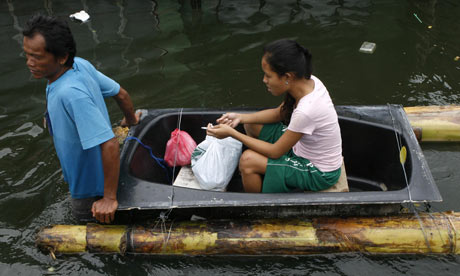<HR>abs-cbnNEWS.com | 10/10/2009 12:09 AM
<TABLE cellSpacing=1 cellPadding=1 width=200 align=right border=0><TBODY><TR><TD>
 </TD></TR><TR><TD> Source: DOH-NEC</TD></TR></TBODY></TABLE>
</TD></TR><TR><TD> Source: DOH-NEC</TD></TR></TBODY></TABLE>MANILA - The Department of Health (DOH) has warned against the outbreak of diseases in evacuation centers filled with victims of Tropical Storm Ondoy.
The DOH estimates that over 13,000 evacuees are sick with diseases like cholera, dengue, malaria, and typhoid fever after being exposed to dirty flood water and subjected to cramped conditions in evacuation centers that hasten the spread of disease.
Data by the health department indicates that half of these evacuees are sick with "minor ailments" like respiratory infections, while 18% are suffering from diarrhea.
About 13% have skin disease and wounds, while 11% have fever, and 1% exhibit flu-like symptoms.
Pasig City residents like Jonalyn Vicente, for example, complain that her husband and children are suffering from severe athlete's foot and diarrhea.
"Eto nga po, nagsusugat na, wala kasing tsinelas, babad lagi ang paa. (Their feet are showing wounds because there are no slippers. Their feet are submerged in flood water)," she said.
The health bureau is also worried about possibly fatal flood-borne diseases like typhoid, cholera, leptospirosis, A H1N1, and hepatitis A.
They are also closely monitoring the spread of dengue and malaria - both mosquito-borne diseases - in areas like Rizal province and Botolan, Zambales.
The spread of typhoid or typhus is pronounced in Laguna province, while Metro Manila evacuees are showing signs of leptospirosis (a disease caused by bacteria from animal feces), A H1N1, and dengue.
Dr. Eric Tayag of the National Epidemiology Center said lack of clean water and the accumulation of excrement in portalets are contributing factors to the spread of bacteria and disease.
"Because of the sheer number of people in evacuation centers, there is a potential for a diarrhea outbreak. People should go home to their houses to avoid this," Tayag said.
For now, the DOH is requesting local government units and evacuees to keep their surroundings clean so that bacteria will not spread.
The health agency's medical staff have also been focusing on distributing Vitamin A supplements and administering vaccinations to typhoon victims.


Comment